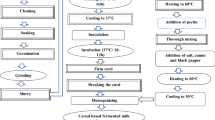Abstract
This study was conducted at Indian Institute of Vegetable Research, Varanasi (I.I.V.R.), Uttar Pradesh from 2006 to 2009 for evaluating comparative physico-chemical, microbiological and sensory attributes of crystallized and Kashi petha at refrigerated storage (4 ± 1 °C) condition up to 90 days. The petha were manufactured using 2 varieties of ash gourd developed at I.I.V.R. i.e.; Kashi Dhawal and Kashi Ujwal, selected based on different parameters suitable for petha sweet preparation. The used packaging materials for storage studies were laminated pouch, low density polyethylene, high density polyethylene. The physiochemical analysis and sensory evaluation were performed at 15 days interval upto 90 days for storage study in both Kashi Petha and crystallized petha, while microbial observation was recorded up to 90 days in crystallized petha and up to 50 days Kashi Petha. Physico-chemical analysis exhibited the continuous increase in moisture (25.79-26.80 % and 31.68-32.63 %) and titratable acidity (0.022-0.029 %) and (0.022-0.030 %) and reduction in ascorbic acid content (5.50-5.00 mg/100 g and 5.12-4.84 mg/100 g), respectively in crystallized and Kashi petha. The increasing trend in microbial population was more pronounced in Kashi petha in comparison to crystallized petha. The spoilage bacteria included Bacillus spp., Staphylococcus spp. and lactic acid bacteria while Aspergillus, Penicillium and Saccharomyces were observed among fungal contaminants. The bacteria, yeast and mold were identified on the basis of cultural, morphological and biochemical characterization with respect to storage period. On the basis of the overall findings of comparative physico-chemical, microbiological and sensory evaluation, 30 and 50 days of storage was considered as safe for the consumption of Kashi and crystallized petha, respectively under refrigerated environment (4 ± 1 °C).
Similar content being viewed by others
References
Agarwal P, Singh B, Sindhu JS (1995) Studies on the physico-chemical and processing characteristics of some newly evolved tomato cultivars for making juice and concentrate. Indian Food Packer 49:45–53
Amerine MA, Pangborn RM, Rossler EB (1965) Principles of sensory evaluation of food. Academic, New York
Aneja KR (2001) In experiment in microbiology, pathology, tissue culture and mushroom production technology, 3rd edn. New Age International (P) Limited, New Delhi
Chawla R, Ranote PS (2009) Preparation and quality evaluation of dehydrated watermelon products. J Food Sci Technol 46:228–231
Chawla P, Ghai S, Sandhu KS (2005) Studies on the nutritional and organoleptic characteristics of carrot pickle during storage. J Food Sci Technol 42:358–360
Deka BC, Sethi V, Suneja P, Srivastava VK (2004) Physico-chemical changes of lime-aonla spiced beverages during storage. J Food Sci Technol 41:329–332
Deka BC, Sethi V, Saikia A (2005) Change in quality of mango-pineapple spiced beverage during storage. Indian J Hort 62(1):71–75
Dhaliwal M, Hira CK (2001) Effect of storage on physico-chemical and nutritional characteristics of carrot-spinach and carrot-pineapple juices. J Food Sci Technol 41:613–617
Dhaliwal M, Hira CK (2004) Effect of storage on physico-chemical and nutritional characteristics of carrot-beetroot and carrot-blackcarrot juices. J Food Sci Technol 38:343–347
Food Standards Australia New Zealand (2001) Guidelines for the microbiological examination of ready-to-eat foods. (http://www.foodstandards.gov.au)
Grover JK, Adiga G, Vats V, Rathi SS (2001) Extract of Benicasa hispida prevent development of experimental ulcer. J Ethno Pharmacol 78:159–164
Kalloo G, Rai M, Kumar R, Prasnna HC, Singh M, Kumar S, Singh B, Ram D, Pandey S, Lal H, Rai S, Pandey KK, Sathpathy S (2006) New vegetable varieties from IIVR Varanasi. Indian Hort 51:16–22
Kannan S, Thirumaran AS (2004) Studies on the storage life of Jamun (Syzygium cuminii Rom) fruit products. J Food Sci Technol 41:186–188
Manay, Swamy S (1996) Food facts and principles. New Age International (P) Ltd, New Delhi
Nayar NM, More TA (1998) Cucurbits. Oxford and IBH Publishing Co. (P) Limited, New Delhi
Osuntogun B, Aboaba OO (2004) Microbiological and physico-chemical evaluation of some Non-alcoholic Beverages. Pakistan J Nutr 3:188–192
Pandey S, Jha A, Rai M (2009) Screening of advance breeding lines/cultivars for shelf-life and biochemical changes during storage of ash gourd (Benincasa hispida). Acta Hort 806:249–255
Ramesh M, Gayathri V, Rao AVNA, Prabhakar MC, Rao CS (1989) Pharmacological action of fruit juice of Benicasa hispida. Fitoterapia 60:241–247
Ranganna S (1997) Handbook of analysis and quality control for fruits and vegetables product, 2nd edn. Tata McGraw-Hill Publishing company limited, New Delhi
Rhodes A, Fletcher DL (1966) Principles of industrial microbiology. Pergaman, Oxford
Robinson RW, Decker-Walters DS (1999) Cucurbits. CAB, Wallingford
Saxena AK, Kulkarni SG, Berry SK, Sehgal RC, Beerh OP (1996) Preparation, packaging and storage of pinni- an Indian traditional sweet. J Food Sci Technol 33:503–505
Singh SV, Jain RK, Gupta AK (2009) Changes in quality of debittered kinnow juice during storage. J Food Sci Technol 46:598–600
Snedecor GW, Cochran WG (1989) Statistical methods, 8th edn. Iowa State University Press, Ames
Acknowledgment
Authors acknowledge the generous support of the Uttar Pradesh Council of Agriculture Research (UPCAR), Lucknow, (Uttar Pradesh) India for providing the fund for the present study.
Author information
Authors and Affiliations
Corresponding authors
Rights and permissions
About this article
Cite this article
Pandey, S., Jha, A., Khemariya, P. et al. Shelf-life and microbiological safety studies of refrigerated petha sweet. J Food Sci Technol 51, 3452–3457 (2014). https://doi.org/10.1007/s13197-012-0856-z
Revised:
Accepted:
Published:
Issue Date:
DOI: https://doi.org/10.1007/s13197-012-0856-z




